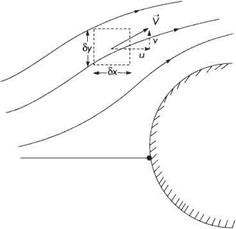Component velocities
In general the local velocity in a flow is inclined to the reference axes O. v, Oy and it is usual to resolve the velocity vector v (magnitude q) into two components mutually at right-angles.
|
Fig. 2.8 An infinitesimal control volume in a typical two-dimensional flow field |
|
|
Fig. 2.9
In a Cartesian coordinate system let a particle move from point P(x, y) to point Q(jc + 8x, у + 6y), a distance of 6s in time St (Fig. 2.9). Then the velocity of the particle is
.. 6s ds lim— = ~r = q s-> о 6t d /
Going from P to Q the particle moves horizontally through 8x giving the horizontal velocity и = dx/dt positive to the right. Similarly going from P to Q the particle moves vertically through 6y and the vertical velocity v = dy/dt (upwards positive). By geometry:
(&)2 = (&c)2 + («y)2
Thus
q2 = i? + v2
and the direction of q relative to the jc-axis is a = tan-1 (v/k).
In a polar coordinate system (Fig. 2.10) the particle moves distance 6s from P(r, в) to Q(r + 8r,6 + 69) in time St. The component velocities are:
radially (outwards positive) qn = ^
d t
tangentially (anti-clockwise positive) qt = r^-
dt
Again
(8s)2 – (8rf + (r69)2
0 (r+8л,9-h 8 в)
|
|
 |
Fig. 2.11
Thus
# = <& + £
and the direction of q relative to the radius vector is given by
/3 = tan-1 ^














